The 2-2-1 full-court zone press
Many coaches commonly use a 1-2-1-1 full-court press because it provides a good opportunity for a quick ball-side trap as the opponent inbounds the ball. It may also be used because coaches are familiar with it and understand it better than other presses. The following 2-2-1 zone press, however, may be a better alternative for your team.
While you can also trap in the 2-2-1, it’s more of a containment-type press, which affords other positive aspects. For example, in a 2-2-1 press, it may be easier to go for multiple traps and at different spots on the floor. It may also bring the clock into play by forcing a time-line violation, causing opponents to panic as the time ticks down. This increases the possibility of turnovers.
2-2-1 zone press
As with all defenses, there are positives and negatives to using a 2-2-1. In a 2-2-1, the middle of the floor is susceptible to posting action by the offensive team. Once the ball gets to this position, your defense can be compromised. Therefore, the coverage of a post in the middle has to be of prime concern, and accomplished with defensive slides and a system of rotations.

DIAGRAM 1: 2-2-1 zone press initial set. The following are the initial alignments and player responsibilities for using a 2-2-1 full-court zone press.
Players 1, 2. Set up between the top of the circle and the foul line extended. “Invite” the offense to inbound the ball to the side and prevent dribble penetration which could split your defenders down the middle.
Backline Players (4, 5). These two defenders must play any flashing or stationary post, because if the offense can get the ball into the middle of the floor it would compromise the defense.
Player 3. Must be a good athlete with good anticipation and court awareness. He or she should set up on the same side of the floor as the inbounder, but be ready to go in either direction. As the ball comes down the sideline and a trap is made, 3 has to take the first ball-side pass.3 also has to quarterback this defense and communicate with his or her teammates, since this defender has the best vision of the floor.

DIAGRAM 2: Initial movements. As the ball is inbounded, channel it down the sideline. 1 needs to set up so that he or she “invites” the pass into the corner. At the same time, 2 has to angle back to help on any post. He or she should be one or two arm-lengths away from the post and 5 should have roughly the same spacing.
A reversal pass along the baseline to the off-side guard is not a problem, because it doesn’t break down the defense. This pass also uses up another valuable second or two which plays into the success of this defense.
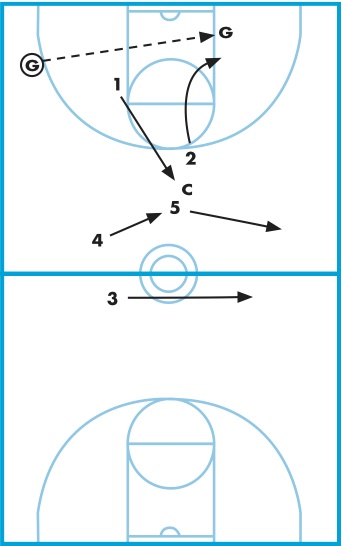
DIAGRAM 3: Defending guard-to-guard ball reversals. If there is a guard-to-guard ball reversal, 2 rotates back up by first protecting the middle of the floor vs. penetration. 1 rotates back on a 45-degree angle to help on any post. 5 releases toward the sideline, 4 rotates to the post and 3 goes to the new ball side of the court.

DIAGRAM 4: Defending sideline channels. When the ball is advanced down the sideline channel, 4 has to slide laterally to cut off the sideline and to form a trap with 1. 4 doesn’t move forward because it would invite a pass over his or her head. 1 only puts enough pressure on the advancing handler so that the dribbler doesn’t have a clear view and can’t survey the floor.
The trap should be made knee to knee by 4 and 1. They should put their hands up to distract the passer, but must not reach in and foul.
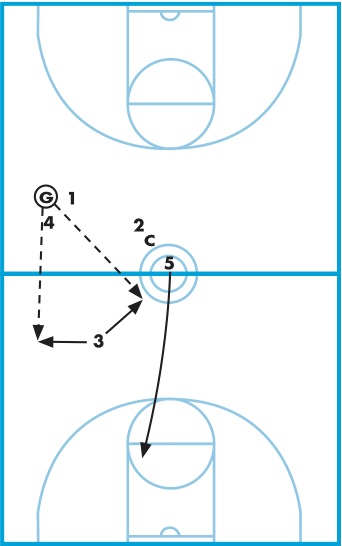
DIAGRAM 5: Anticipating upcourt passes. As the trap between 4 and 1 is made, 2 has to drop and get a hand on any possible post player or pass and 3 anticipates and takes the first ball-side pass. 5 has to rotate back to protect the basket.
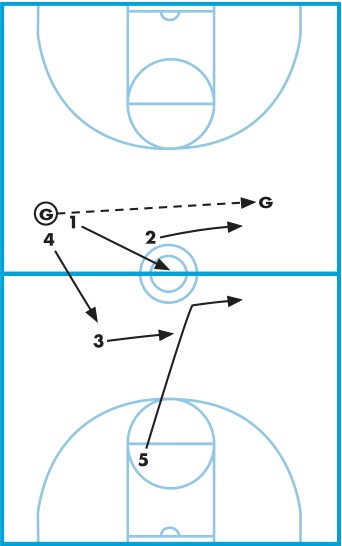
DIAGRAM 6: Ball reversal at half court. If the ball is reversed before it crosses half court, 2 releases from the post to form a trap on either side of the midcourt line. 5 rotates up, preventing dribble-penetration first to the middle of the floor and secondly down the sideline. 3 sprints across, 4 rotates back to protect the hoop and 1 releases to any post in the middle of the floor.

DIAGRAM 7: Other 2-2-1 looks. To add another look and more pressure as the offense is inbounding the ball, 1 and 2 can face-guard the opponent’s guards. Even if the offense employs a 1-4 entry set, 1 and 2 would cover their guards.
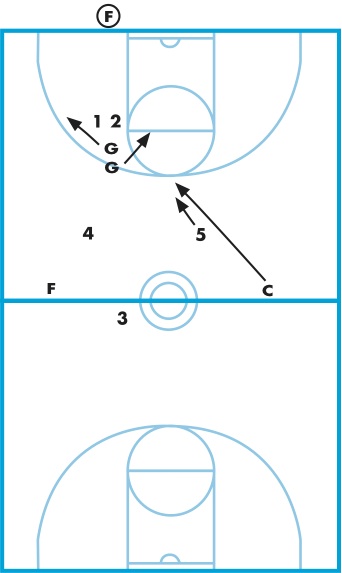
DIAGRAM 8: Defending big players flashing to the ball. If the offensive forward or center flashes to the ball from midcourt, 4 or 5, has to cover this option and prevent that player from turning and seeing other players going toward their end of the floor.
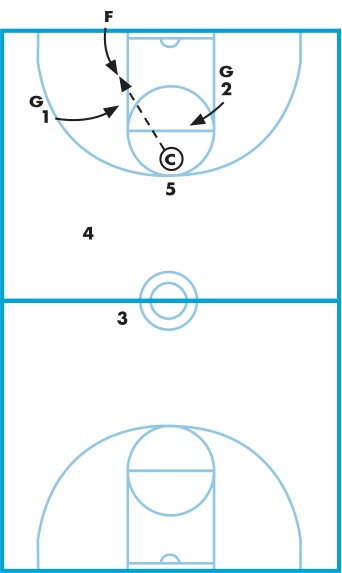
DIAGRAM 9: Defending passes back to trail player. The 2-2-1 press is versatile in that any pass back to a trailing guard or to the inbounder allows the press to adjust. 1 moves into the middle of the floor in order to channel the ball handler down the side. 2 angles back to the post.












